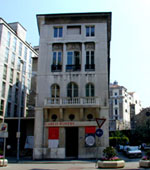Palazzo Costanzi (metà settecento)
piazza Piccola 3
Arch. Pietro Nobile
The Costanzi family commissioned Pietro Nobile to design a property fund from the mid-18th century. The study presents many problems both for the variety of the soil and for the discovery of the archaeological remains of a Roman port.
Shortly before leaving for Vienna, Nobile plans, according to local memory, a building for Giobatta Costanzi, chancellor of health. In 1840 another owner took over, Daniele Caroli, who called the architect Valentino Valle the following year to add a part of the building to that already existing since 1817 according to the same model. Eight years later Panajotti Giorguli purchases the whole complex which is now used as municipal offices and in a part of the ground floor as an exhibition hall.
A questionable urban solution and a traumatic restoration intervention have altered the original appearance of the building which, however, still maintains its sober dignity in its compositional lines.
The facades towards Piazza Piccola and at the two ends of the building on Via della Muda Vecchia have three simple openings on each side, surmounted by three oculi of Palladian memory. On the first floor a balcony with three arched portals on a light ashlar masonry wall; on the upper floor there are three windows with a bas-relief decoration flanked by two Doric columns with capitals, which follow the model of the Parthenon in Athens; on the top floor a further row of windows. The rest of the building shows six Doric pilasters, a series of windows and below another series of openings in the center.
The extreme cleanliness of the façade, which gives nothing to the decorative factor, suffers from a certain classicism filtered through the study of the antique in Palladio
In the interior, the main staircase is noteworthy. With a square plan and overlooking a semicircular environment, it has two Doric columns on the ground floor and the first floor and two of the Ionic order on the second. Here the author, unlike the other projects, uses columns with capitals that follow the indications of the sixteenth-century theorists on the use of orders.








